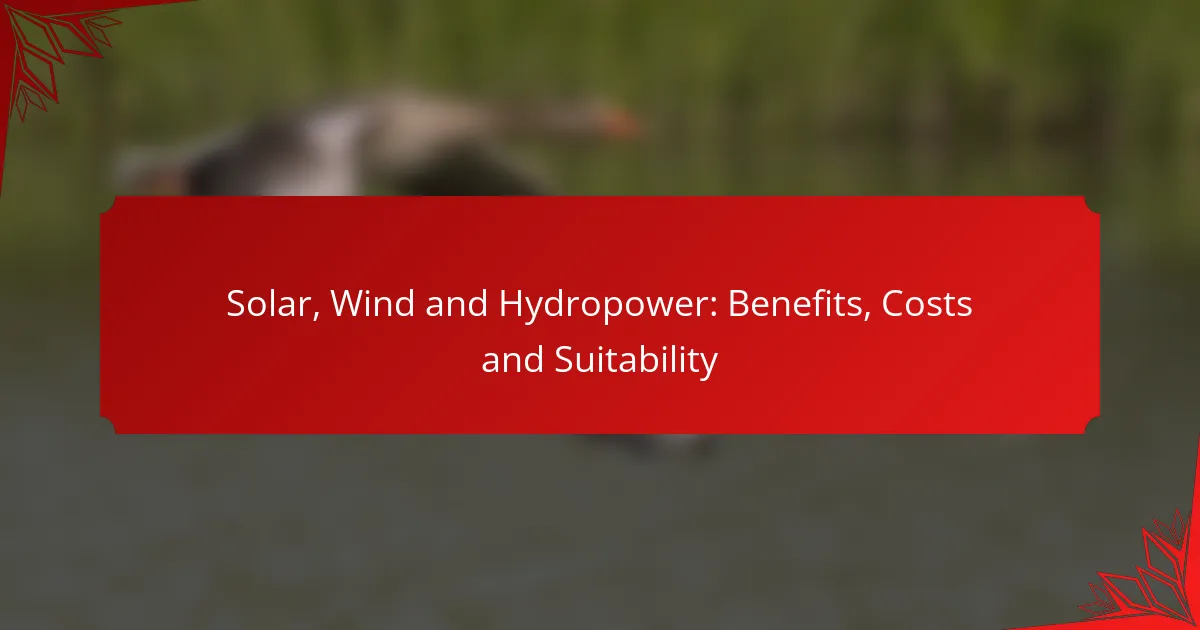Emerging renewable energy technologies are revolutionizing the energy landscape by enhancing efficiency and reducing costs while promoting sustainability. Innovations such as advanced solar photovoltaic systems, cutting-edge offshore wind solutions, and hydrogen fuel cell developments are driving a transition towards cleaner energy sources. These advancements not only improve energy production but also offer significant economic benefits, including job creation and investment opportunities, fostering a more sustainable future.
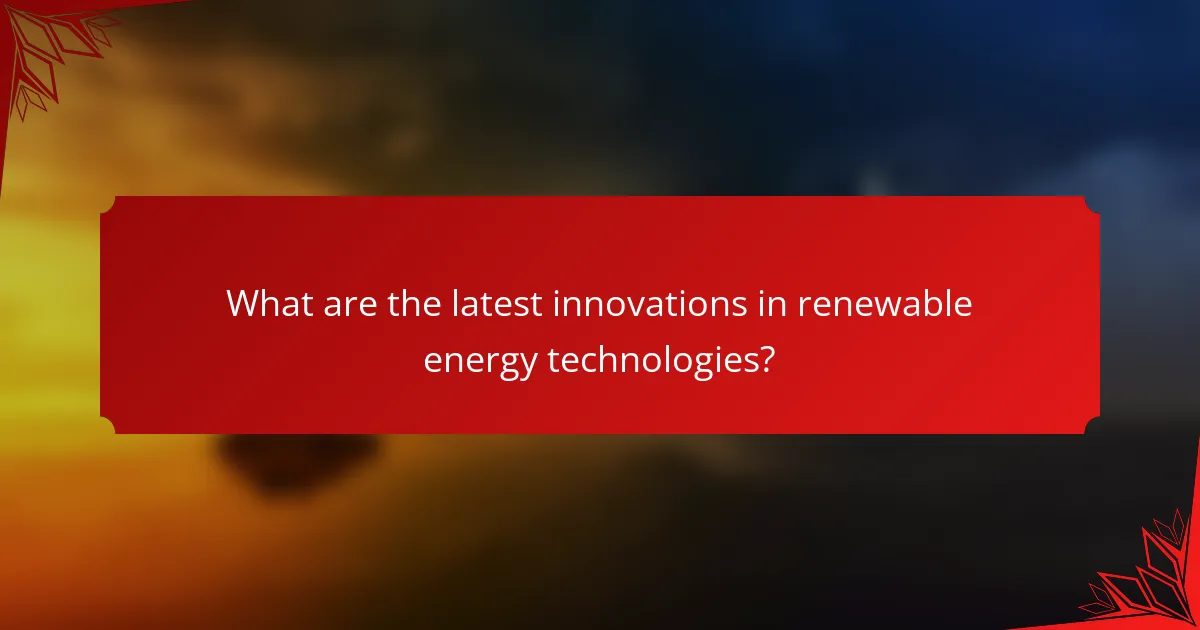
What are the latest innovations in renewable energy technologies?
The latest innovations in renewable energy technologies focus on increasing efficiency, reducing costs, and enhancing sustainability. Key advancements include improved solar photovoltaic systems, innovative offshore wind solutions, and developments in hydrogen fuel cells, all contributing to a cleaner energy future.
Solar photovoltaic advancements
Recent advancements in solar photovoltaic (PV) technology have led to higher efficiency rates and lower production costs. Innovations such as bifacial solar panels, which capture sunlight from both sides, can increase energy generation by up to 30% compared to traditional panels.
Additionally, the integration of solar tracking systems allows panels to follow the sun’s path, further enhancing energy capture. These technologies are becoming increasingly accessible, with many countries offering incentives to promote solar adoption.
Offshore wind energy developments
Offshore wind energy is experiencing significant growth, driven by larger turbines and improved installation techniques. Modern turbines can exceed 10 MW in capacity, generating substantial power even in lower wind conditions.
Floating wind farms are emerging as a game-changer, allowing installations in deeper waters where winds are stronger and more consistent. This technology is particularly promising for regions with limited coastal land, such as parts of Europe and the United States.
Hydrogen fuel cell technology
Hydrogen fuel cell technology is advancing rapidly, providing a clean energy source for various applications, including transportation and power generation. These cells convert hydrogen into electricity, emitting only water vapor as a byproduct.
Recent innovations have focused on reducing production costs and improving efficiency. Green hydrogen, produced using renewable energy sources, is gaining traction, with countries like Germany and Japan investing heavily in infrastructure to support its use.
Energy storage solutions
Energy storage solutions are crucial for balancing supply and demand in renewable energy systems. Innovations in battery technology, such as lithium-ion and solid-state batteries, are enhancing storage capacity and reducing costs.
Additionally, alternative storage methods, like pumped hydro and compressed air, are being explored to provide large-scale energy storage. These developments are essential for integrating intermittent renewable sources like solar and wind into the grid effectively.
Geothermal energy enhancements
Geothermal energy technology is evolving with improved drilling techniques and enhanced geothermal systems (EGS). These advancements allow for the extraction of heat from deeper geological formations, expanding the potential for geothermal energy beyond traditional hotspots.
Countries with significant geothermal resources, such as Iceland and the Philippines, are leading the way in utilizing this renewable energy source. Enhanced systems can provide a stable and reliable energy supply, making geothermal a key player in the transition to sustainable energy.
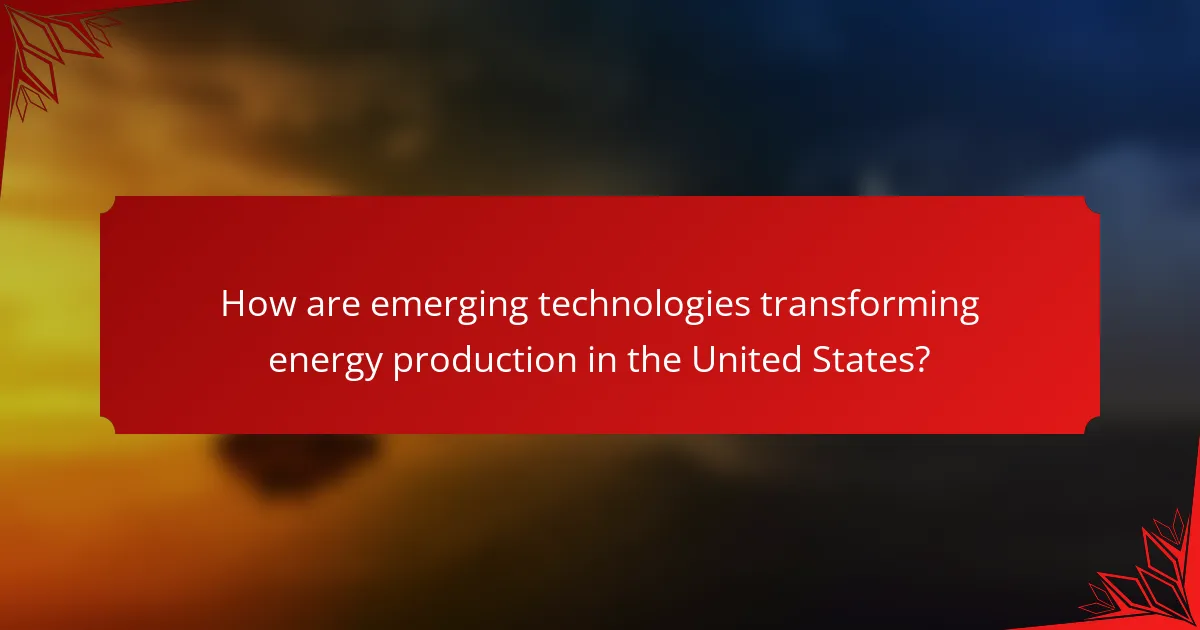
How are emerging technologies transforming energy production in the United States?
Emerging technologies are significantly enhancing energy production in the United States by improving efficiency, expanding renewable sources, and integrating advanced grid systems. These innovations are paving the way for a more sustainable and reliable energy landscape.
Increased efficiency in solar panels
Recent advancements in solar panel technology have led to higher efficiency rates, allowing for more energy generation from the same surface area. New materials, such as perovskite, are being developed to complement traditional silicon cells, potentially increasing efficiency to over 30% in laboratory settings.
Homeowners and businesses can benefit from these innovations by installing high-efficiency panels, which can reduce energy costs and increase energy independence. Incentives like the federal solar tax credit can further offset installation costs, making it a financially attractive option.
Expansion of wind farms
The expansion of wind farms across the U.S. is driven by advancements in turbine technology and a growing demand for clean energy. Modern turbines are larger and more efficient, capturing wind energy at lower speeds and generating more power, which can lead to cost reductions in energy production.
States like Texas and Iowa are leading the way, with wind energy contributing significantly to their energy portfolios. As of recent years, wind power has become one of the most cost-effective sources of electricity, often competing with fossil fuels on price.
Integration of smart grids
Smart grid technology is revolutionizing how energy is distributed and consumed in the United States. By utilizing digital communication and automation, smart grids enhance the reliability and efficiency of electricity delivery, allowing for better integration of renewable energy sources.
Consumers can take advantage of smart meters that provide real-time data on energy usage, enabling them to adjust their consumption patterns and save on electricity bills. Additionally, utilities can better manage demand and supply, reducing the need for costly peak power plants.

What are the economic benefits of adopting renewable energy technologies?
Adopting renewable energy technologies offers significant economic benefits, including job creation, lower energy costs, and new investment opportunities. These advantages contribute to a more sustainable economy and can enhance local and national financial stability.
Job creation in green sectors
The transition to renewable energy technologies is a major driver of job creation in various green sectors. Positions in solar and wind energy, energy efficiency, and sustainable transportation are rapidly growing, often outpacing job growth in traditional fossil fuel industries.
For instance, jobs in solar panel installation and maintenance have seen substantial increases, with many regions reporting growth rates in the double digits. This shift not only provides employment but also fosters local economies by creating demand for skilled labor and supporting related industries.
Reduction in energy costs
Renewable energy technologies can lead to significant reductions in energy costs for consumers and businesses. As technologies like solar and wind become more efficient and widespread, the cost of generating electricity from these sources continues to decline.
For example, many households that invest in solar panels can expect to see their energy bills decrease by 30-50% over time, depending on local incentives and energy prices. This shift not only saves money but also provides greater energy independence and stability against fluctuating fossil fuel prices.
Investment opportunities in clean tech
The renewable energy sector presents numerous investment opportunities, attracting capital from both private and public sources. Investors are increasingly recognizing the potential for high returns in clean technology, driven by growing demand for sustainable solutions.
Venture capital and private equity firms are focusing on startups that innovate in areas like energy storage, electric vehicles, and smart grid technology. As governments worldwide implement policies to support clean energy, the market for these technologies is expected to expand, offering investors a chance to capitalize on this growth.

What are the challenges facing renewable energy adoption?
Renewable energy adoption faces several significant challenges that can hinder its widespread implementation. Key issues include infrastructure limitations, regulatory hurdles, and public perception and awareness, all of which require careful consideration to facilitate a smoother transition to sustainable energy sources.
Infrastructure limitations
The existing energy infrastructure often lacks the capacity to integrate renewable sources effectively. Many regions have outdated grids that are not equipped to handle the variability of solar and wind energy, leading to inefficiencies and potential outages.
Upgrading infrastructure can be costly and time-consuming, requiring substantial investment from both public and private sectors. For example, smart grid technologies can improve energy distribution but may take years to implement fully.
Regulatory hurdles
Regulatory frameworks can create barriers to renewable energy projects. Complex permitting processes, inconsistent policies across regions, and lack of incentives can slow down the development of new technologies.
To navigate these hurdles, stakeholders should engage with policymakers to advocate for clearer regulations and supportive measures, such as tax credits or grants. Understanding local laws and regulations is crucial for successful project planning.
Public perception and awareness
Public perception plays a significant role in the acceptance of renewable energy technologies. Misconceptions about the reliability, cost, and environmental impact of renewables can lead to resistance from communities and decision-makers.
Increasing awareness through education campaigns and community engagement is essential. Demonstrating the benefits of renewable energy, such as job creation and reduced emissions, can help shift public opinion positively.
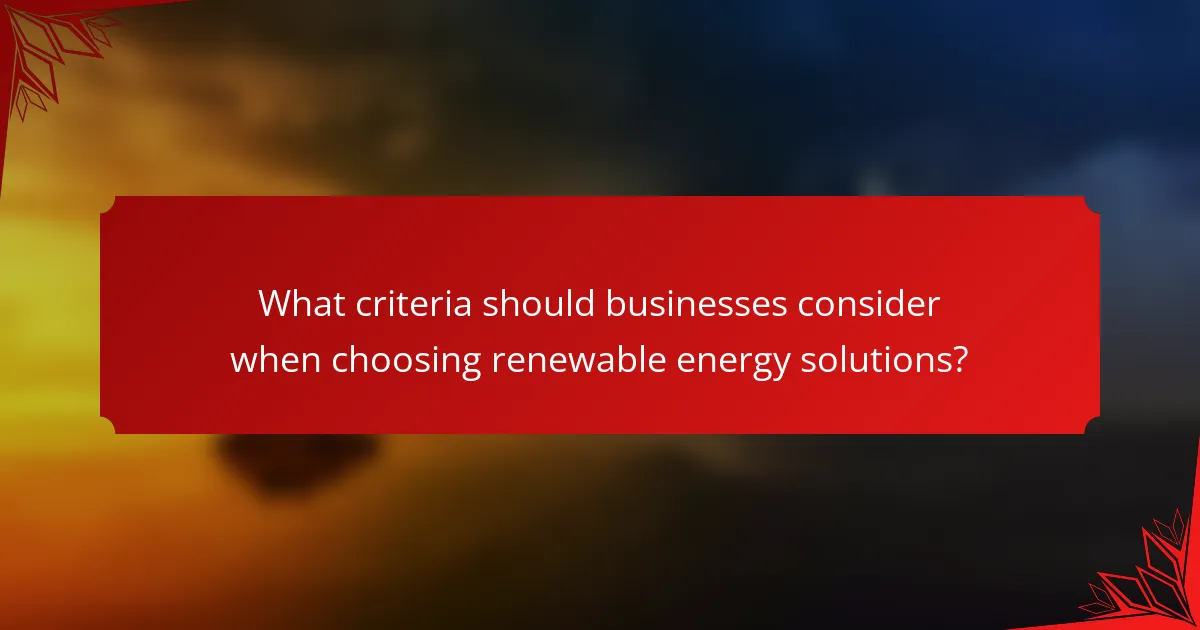
What criteria should businesses consider when choosing renewable energy solutions?
Businesses should evaluate several key criteria when selecting renewable energy solutions, including cost-effectiveness, scalability, and compatibility with existing systems. These factors help ensure that the chosen technology aligns with operational goals and financial constraints.
Cost-effectiveness analysis
Cost-effectiveness is a critical factor in choosing renewable energy solutions. Businesses should analyze both upfront capital costs and long-term operational expenses, including maintenance and potential savings on energy bills. Comparing the levelized cost of energy (LCOE) for different technologies can provide a clearer picture of financial viability.
For instance, solar and wind energy often have low operating costs after installation, making them attractive options. However, initial investment can vary significantly, so conducting a thorough cost-benefit analysis is essential.
Scalability of technology
The scalability of renewable energy technologies is vital for businesses anticipating growth or changes in energy needs. Solutions should be adaptable to increasing energy demands without requiring complete overhauls. For example, modular solar panel systems can be expanded as needed, allowing businesses to start small and scale up efficiently.
Evaluating the scalability of a technology also involves considering the availability of resources and infrastructure. Some renewable solutions may be limited by geographic or regulatory factors, impacting their ability to grow with the business.
Compatibility with existing systems
Compatibility with existing energy systems is crucial for a smooth transition to renewable energy. Businesses should assess how new technologies will integrate with current infrastructure, such as electrical grids and energy management systems. This can help avoid costly retrofitting or operational disruptions.
For example, hybrid systems that combine renewable sources with traditional energy can provide a seamless transition while maintaining reliability. Additionally, ensuring that the chosen technology complies with local regulations and standards can facilitate easier implementation and operation.
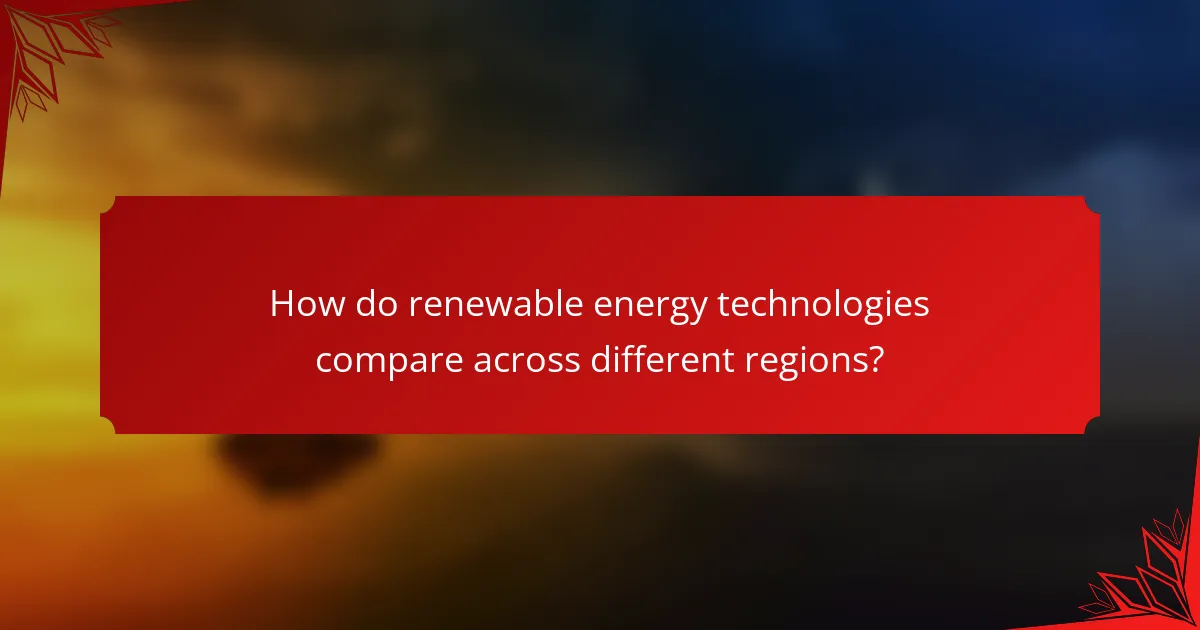
How do renewable energy technologies compare across different regions?
Renewable energy technologies vary significantly across regions due to factors like climate, government policies, and available resources. Regions with abundant sunlight, wind, or hydro resources tend to adopt specific technologies that best utilize their natural advantages.
Solar energy potential in California
California is a leader in solar energy, benefiting from high solar irradiance and supportive state policies. The state has implemented various incentives, such as tax credits and rebates, to encourage solar panel installations, making it an attractive option for homeowners and businesses alike.
With over 30% of its energy coming from renewable sources, a significant portion is derived from solar power. The average cost of solar installations in California ranges from $15,000 to $25,000, depending on system size and technology, but many homeowners can recoup their investment within 5 to 7 years through energy savings.
For those considering solar energy in California, it’s essential to evaluate local regulations and utility incentives. Engaging with a certified installer can help navigate these options and ensure compliance with state standards, maximizing the benefits of solar energy adoption.

